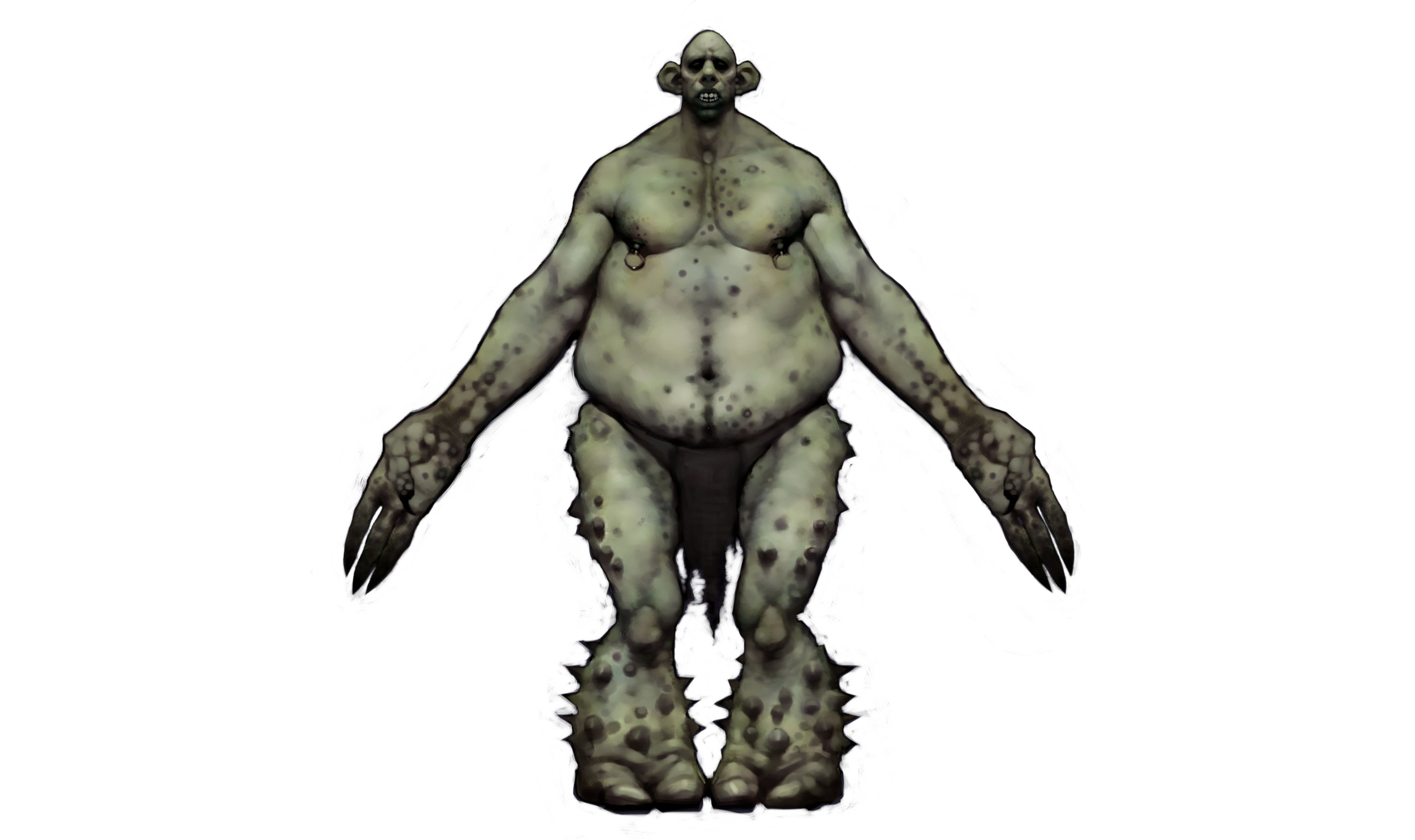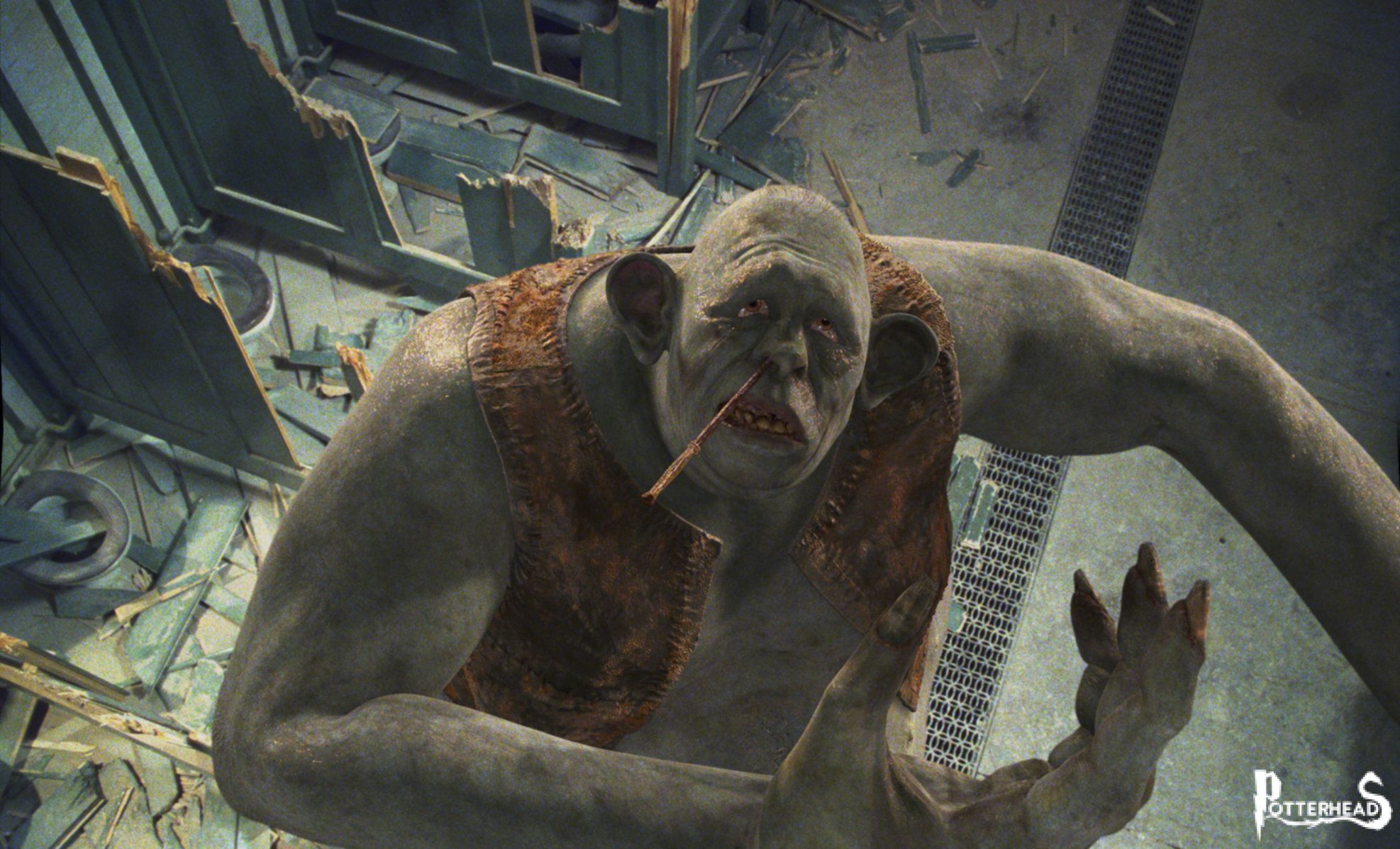Testo tradotto (italiano) link
Guida di Pottermore ai troll
Harry Potter e la Pietra Filosofale presentano una serie di creature mitiche con un lungo elenco di apparizioni precedenti nella letteratura e nel folklore. Qui esaminiamo la storia dei troll.
La Pietra Filosofale ci ha presentato i troll del mondo magico: sono grandi, brutali e più che un po' stupidi. Ma i troll erano nell'esistenza (fittizia), molto prima che la bacchetta di Ron si fosse bloccata sulla narice di quella brutta creatura in particolare nel bagno di
Mirtilla Malcontenta. Quindi, da dove vengono esattamente?
Torna in cima
Bestie o esseri? link
Animali Fantastici e Dove Trovarli, scritto da J.K. Rowling come Newt Scamander, descrive un troll come "una creatura temibile fino a 12 piedi di altezza e che pesa una tonnellata". Originari della Scandinavia, spiega Newt, sono forti e imprevedibili creature con una propensione verso la violenza e la stupidità.
Infatti, la stupidità dei troll è ciò che ha causato la loro catalagozione come bestie, dopo che i primi tentativi di magia della classificazione identificavano "qualsiasi membro della comunità magica che camminava su due zampe" come "essere", distinto dalle "bestie" che volavano o camminavano su quattro zampe.
Secondo Animali Fantastici, i troll sono stati usati dai goblin per dimostrare quanto fosse assurdo questo metodo di classificazione. Quando fu poi annullata, la mancanza di comprensione dei troll era la chiave per il loro essere chiamato "bestie".
Torna in cima
Radici scandinave link
Forti, imprevedibili, stupidi e violenti - sono tutti i tratti che sono veri per i troll della mitologia. I troll hanno origine in Scandinavia, con fiabe come “Le tre capre sgarbate di Billy" gradualmente incorporati nella cultura popolare.
Torna in cima
Storia antica link
La parola "troll" è apparsa per la prima volta nel 1276, quando il re Magnus Haakonsson di Norvegia creò una serie di leggi che hanno reso illegale risvegliare i Troll "abitanti della collina“, che erano effettivamente le tombe degli antenati pagani sepolti in cima alla collinetta. Adorare questi antenati era una pratica che l'élite cristiana della Norvegia desiderava togliere. La creazione di queste leggi del re Magnus comprendeva la prima prova scritta della parola "troll", e così i troll si associarono ai pagani scandinavi del XIII secolo.
Ma la parola ha una storia ancora più lunga. Nel primo folclore norvegese, i troll si riferivano a un particolare tipo di magia che erano stati progettati per fare del male, e può anche essere ricondotto a parole primitive tedesche che significano giganti, mostri o fantasmi.
Torna in cima
I troll della mitologia erano mostruosi, ma anche se sono stati legati a una razza di giganti norvegesi conosciuti come 'jötnar', non erano sempre enormi. Nei paesi scandinavi meridionali erano spesso rappresentati come piccole, misteriose creature abitate in grotta.
I troll del folklore precoce hanno altrettanti diversi habitat come variano le apparenze. Alcune storie li vedono vivere in montagna, altri in grotte, o in foreste. Quindi, quando Newt identifica tre tipi di troll nel libro di testo Animali Fantastici: montagna, foresta e fiume - la sua descrizione ha le sue radici nei miti esistenti.
Torna in cima
Dal mito antico alla narrativa moderna, i troll sono sempre stati brutti. La ballata danese "Eline di Villenskov" include una parte che descrive i troll come "brutti e tristi” e questo è stato diffuso fino la nostra cultura popolare.
Torna in cima
Interpretazioni alternative link
Ci sono state altre interpretazioni visive dei troll. Il nome svedese di Moomins, autore finlandese di Tove Jansson, è 'Mumintroll', perché le popolazioni simili a ippopotami bianche hanno radici nelle vecchie fate - anche se i pacifici Moomins non sono per niente come le creature distrutte del mondo magico.
E nel 1959, un taglialegna danese chiamato Thomas Dam creò una bambola di plastica con un volto rugoso e capelli crespi. Le sue creazioni sono diventate note come bambole di Troll e il film animato Trolls del 2016 li ha portati all'attenzione popolare.
Come Moomins, i troll della diga non sono spaventosi o particolarmente stupidi, che vanno solo a dimostrare che anche le creature mostruosamente magiche del folclore possono, con un po 'di aiuto, cambiare la loro reputazione.
Non ci sono tali cambi di reputatazione per i troll del mondo magico. Quello che possiamo dire su quello che Harry, Ron e Hermione incontrano nella Pietra Filosofale, è che almeno non ha causato danni, grazie alla bacchetta di Ron e alla speciale affinità di Raptor verso il loro genere.
Non è esattamente una lode. Ma molto meglio della definizione di Newt in Animali Fantastici.
Torna in cima
Testo originale (inglese) link
Pottermore’s guide to trolls
Harry Potter and the Philosopher’s Stone features a host of mythical creatures with a long list of previous appearances in literature and folklore. Here, we take a look at the history of trolls.
Philosopher’s Stone introduced us to the trolls of the wizarding world: they’re big, brutish and more than a little bit stupid. But trolls were in (fictional) existence long before Ron’s wand got stuck up the nostril of that particularly nasty one in Moaning Myrtle’s bathroom. So, where exactly do they come from?
Beasts or beings?
The Fantastic Beasts and Where to Find Them textbook, written by J.K. Rowling as Newt Scamander, describes a troll as ‘a fearsome creature up to twelve feet tall and weighing a tonne’. They originated in Scandinavia, Newt explains, and they are strong, unpredictable creatures with a propensity towards violence and stupidity.
In fact, the stupidity of trolls is what caused them to be officially listed as beasts, after early wizarding attempts at classification identified ‘any member of the magical community that walked on two legs’ as a ‘being’, distinct from the ‘beasts’ that flew or crawled on four legs.
According to Fantastic Beasts, trolls were used by goblins to demonstrate how absurd this method of classification was. When it was later overturned, the trolls’ lack of understanding was key to their being termed ‘beasts’.
Scandinavian roots
Strong, unpredictable, stupid and violent – these are all traits that are true of the trolls of mythology. Trolls did originate in Scandinavia, with early fairy tales like ‘The Three Billy Goats Gruff’ gradually embedding them in popular culture.
Early history
The word ‘troll’ first appeared in 1276, when Norway’s King Magnus Haakonsson created a set of laws that made it illegal to wake the trollish ‘mound dwellers’, which were actually the graves of early pagan ancestors buried in mounds of earth. Worshipping these ancestors was a practice that the Christian elite of Norway were keen to stamp out. King Magnus’s creation of these laws included the first written record of the word ‘troll’, and so trolls became associated with the Scandinavian pagans of the thirteenth century.
But the word has an even longer history. In early Norse folklore, ‘trolleri’ referred to a particular type of magic that was designed to do harm, and it can also be traced back to early German words meaning giant, monster or fiend.
Habitat
The trolls of mythology were monstrous, but although they have been linked to a race of Norse giants known as ‘jötnar’ they weren’t always huge. In the southern Scandinavian countries they were often depicted as small, mysterious, cave-dwelling creatures.
The trolls of early folklore have as many different habitats as they do variations in appearance. Some stories have them living in mountains, others in caves, or in forests. So when Newt identifies three types of troll in the Fantastic Beasts textbook: mountain, forest and river – his description has its roots in existing myths.
Appearance
From ancient myth to modern fiction, trolls have always been ugly. The Danish ballad ‘Eline of Villenskov’ includes a line that describes trolls as ‘both ugly and grim’ and this has filtered through to our popular culture.
Alternative interpretations
There have been other visual interpretations of trolls. The Swedish name for Finnish author Tove Jansson’s Moomins is ‘Mumintroll’, because those popular, white hippopotamus-like creatures also have roots in the old fairytales – although the peaceful Moomins are nothing like the destructive creatures of the wizarding world.
And, in 1959, a Danish woodcutter called Thomas Dam created a plastic doll with a wrinkled face and upcombed hair. His creations became known as Troll dolls, and the 2016 animated film Trolls brought them back to popular attention.
Like Moomins, Dam’s trolls aren’t scary or particularly stupid, which just goes to show that even folklore’s most monstrously magical creatures can, with a bit of help, change their reputation.
There are no such reputational makeovers for the trolls of the wizarding world. The best we can say for the two that Harry, Ron and Hermione encounter in Philosopher’s Stone is that at least they caused no harm, thanks to Ron’s wand and Quirrell’s special affinity with their kind.
It’s not exactly high praise. Best stick to Newt’s definition in Fantastic Beasts.
To celebrate the 20th anniversary of Harry Potter and the Philosopher’s Stone, every Friday Pottermore will explore themes, moments, characters and much more from the very first Harry Potter story. Come back next week when we look at the magical spells we first learned in Philosopher’s Stone.




 Testo tradotto (italiano)
Testo tradotto (italiano)

